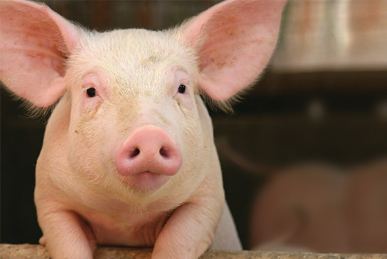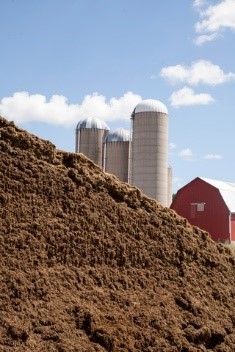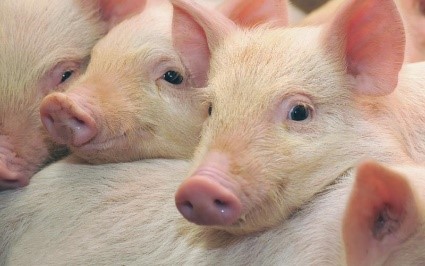
North America

Europe

Latin America

Asia Pacific

Africa

Middle East

North America

Europe

Latin America

Asia Pacific

Africa

Middle East
Vaše životinje ovisi o vama. Performanse ovise o odgovarajućem mineralu.
Osigurajte to uz pomoć Alltechova® programa za upravljanje mineralima za bolju adsorpciju, manje gubitaka i optimalno zdravlje.
Upravljanje mineralima nije samo način da se spriječi nedostatak minerala. Neodgovarajući dodaci mogu imati ozbiljne posljedice za zdravlje i produktivnost životinja. Tradicionalne metode dodavanja minerala uključivale su upotrebu anorganskih minerala, koje životinje loše adsorbiraju. To je na mnogim tržištima dovelo do prelaska na dodavanje organskih minerala.
Predlažemo da promijeniti tradicionalan način korištenja minerala i hranite svoje životinje na suvremeni način. Alltech® je dokazao da se organski mikrominerali u obliku Bioplexa® i Sel-Plexa® mogu koristiti u znatno manjim dozama i poboljšati proizvodne osobine. Na taj se način optimizira potreba životinje za mineralima i smanjuje negativan učinak na okoliš. Tu inovaciju nazivamo Alltech’s Total Replacement Technology™ (TRT – tehnologija potpune zamjene).
Alltechov program za upravljanje mineralima jamči da životinje bolje adsorbiraju, pohranjuju i iskorištavaju organske minerale. To zadovoljava povećane potrebe za hranjivim tvarima u suvremenom uzgoju stoke kako bi se postigao rast, dobri reproduktivni rezultati i zdravlje životinja.

Alltechov® program za upravljanje zdravljem probavnog sustava nužna je osnova za dobre proizvodne osobine tijekom životnog vijeka životinje i profitabilnost.
Naše tehnologije za zdravlje probavnog sustava temelje se na opsežnim istraživanjima koja uključuju više od 730 pokusa. Kako se na globalnoj razini donose sve stroži propisi za upotrebu antibiotika, mi pružamo provjerena rješenja za integritet probavnog trakta i dobrobit životinja.
Alltechov® program za upravljanje zdravljem probavnog sustava ima za cilj:

Alltechov program E=P+S sastoji se od niza dijelova koji, kada se uzimaju zajedno, pružaju poljoprivrednicima kompletan paket revizije i preporuka za sve jedinice na farmi.
Prvi dio je proizvodnja i kvaliteta silaže. To je temeljno načelo Alltechova programa E = P + S, u kojem je učinkovitost zbroj profitabilnosti i održivosti. Alltech može predvidjeti ekonomske rezultate i istaknuti očekivano smanjenje emisija ugljika na temelju predviđenih dodatnih povećanja učinkovitosti. Ovaj program pomaže predvidjeti i pratiti prednosti na farmi, kao i jasno pokazati prednosti uz pomoć našeg jedinstvenog alata „Što ako?"
Prema Kevinu Dardisu, Alltechovom globalnom marketinškom menadžeru za mliječnu industriju, stvar je jednostavna.
„Poljoprivrednici traže mogućnosti koje se nude u mliječnoj i mesnoj industriji", kazao je. „Alltech je jedinstveno pozicioniran kako bi pomogao u rješavanju neučinkovitosti i povećanju profitabilnosti na održiviji način."
Alltechov program E=P+S se sastoji od niza dijelova koji, kada se uzimaju zajedno, pružaju poljoprivrednicima kompletan paket revizije i preporuka za sve jedinice na farmi.
Prvi dio je proizvodnja i kvaliteta silaže. To se dalje kombinira sa savjetima o izradi obroka za životinje i specifikacijama za minerale. Nakon toga naši tehničari vrše reviziju upravljanja farmom pomoću Alltechova programa. Također provodimo pregled stajskog gnojiva kako bismo pomogli identificirati količinu hrane koja prolazi kroz rumen neprobavljena, što predstavlja gubitak.
Naši tehničari su u potpunosti obučeni za izradu obroka pomoću Plurimixa, namjenskog programa za formulacije. Plurimix modelira postojeću hranidbu i omogućuje usporedbu potencijalnih prednosti alternativne hranidbe. Sva se hrana može usporediti nutritivno, cjenovno i prema količini ugljika koji se generira određenom hranom. Te se informacije zatim mogu prenijeti, zajedno s osnovnim operativnim pokazateljima uspješnosti farme, u jedinstveni Alltechov alat „Što ako?". Izračuni pokazuju kolika je korist od riješenih neučinkovitosti za poljoprivrednike, uz dodatni bonus smanjenja ugljičnog otiska stada, što je odlična vijest za potrošače, koji su danas, više no ikada do sada, zainteresirani za način na koji se proizvodi hrana.
Svi su ovi dijelovi objedinjeni u sveobuhvatnu preporuku za hranidbu, specifikacije minerala, alternativne izvore bjelančevina i, ako je potrebno, kontrolu mikotoksina. Nakon provedbe tehničari redovito prate rezultate i performanse kako bi osigurali postizanje ili unapređivanje predviđenih poboljšanja.
Ako želite saznati više, obratite se lokalnom predstavniku tvrtke Alltech.
Kontaminiranost mikotoksinima je sve više prisutna na farmama i potencijalna su prijetnja produktivnosti čak i farmama kojima se najbolje upravlja, pa bi svi stočari i proizvođači stočne hrane trebali stalno biti na oprezu.
Alltech je razvio globalno rješenje za suzbijanje mikotoksina kombinacijom programa i tehnologija za upravljanje mikotoksinima. Učinkovito upravljanje mikotoksinima odnosi se na cjelovit pristup problemu, od farme do tvornice stočne hrane, i od procjene rizika do upravljanja hranidbom. Alltechov program upravljanja mikotoksinima nudi niz rješenja kako bi ublažili prijetnje s kojima se možete suočiti na polju ili u skladištu.
Za više informacija o našem programu i proizvodima posjetite

Alltechov program smanjenja upotrebe antibiotika osmišljen je kao potpora uzgajivačima za ostvarivanje zdrave i profitabilne budućnosti njihovih farmi. Program se temelji na više od 40 godina istraživanja i praktične primjene uz pomoć suvremenih alata i tehničkih stručnjaka, te nudi cjelovit pristup koji pomaže proizvođačima da se nose s izazovima koji se mogu pojaviti u uzgoju zdrave životinje uz smanjenu upotrebu antibiotika.
U Alltechu smatramo da se maksimalni potencijali životinja i farme najbolje može ostvariti u partnerstvom s proizvođačima.
Kako bi pomogli proizvođačima da budu konkurentniji, u program su uključene i usluge s dodanom vrijednosti koje otklanjaju probleme, pomažu proizvođačima postići zacrtane ciljeve i stvaraju osnovu za profitabilnu i održivu budućnost.

KEENAN® strojevi jedinstveni su zbog dokazanih nutritivnih dobrobiti.
Tvrtka KEENAN osnovana je 1978. sa sjedištem u Borrisu, Co. Carlow u Irskoj, i jedan je od lidera na području inovativnih i profitabilnih rješenja za farme. Glavni joj je cilj povećati stopu konverzije hrane i produktivnost životinja. Tijekom gotovo 40 godina tvrtka KEENAN stekla je reputaciju u proizvodnji kvalitetnih mikser prikolica najsuvremenijeg dizajna, a njihovi se strojevi danas koriste za hranidbu životinja u preko 70 zemalja svijeta.

Alltech Hrvatska d.o.o., Josipa Lončara 3, 10090 Zagreb
Telefon: 00385/1/2339 588
E-mail: croatia@alltech.com
Fax: 00385/1/2339 008
 Alltech® Café CitadelleAlltech® Café Citadelle je “šalica nade” za Haiti. Nakon razarajućeg potresa na Haitiju 2010., osnivač Alltecha, dr. Pears Lyons, želio je pokrenuti održivo poslovanje s lokalnim draguljem: Arabica kavom koja se u cijelosti uzgaja u planinama i ima oznaku Fair Trade Certified™. Kavu stavljamo na tržište i prodajemo u zrnu pod nazivom Café Citadelle , a koristimo ju i za pripremu našeg tamnog piva Kentucky Bourbon Barrel Stout®. Sav profit od prodaje Café Citadelle ulaže se u Haiti, gdje se ponovno investira u dvije osnovne škole na sjeveru Haitija. |
|
|
 Pearse Lyons destilerija u St. JamesuBogata obiteljska povijest, osobna strast prema proizvodnji piva i žestokih pića i poduzetnički duh doveli su do pokretanja jedne od novih destilerija u Dublinu u kojoj se proizvodi irski viski, Pearse Lyons Distillery at St. James. Osnovali su ju dr. Pearse i gđa. Deirdre Lyons, a destilerija je povijest u novoj verziji. Pearse Lyons je potomak pet generacija bačvara koji su izrađivali bačve za destilerije u Dublinu. Ima doktorat iz fermentacije kvasaca i prvi je Irac koji je dobio formalnu diplomu fakulteta British School of Malting and Brewing iz proizvodnje piva i žestokih pića. Dok je studirao, stažirao je u Guinnesu i Harp Lageru, a kasnije je radio kao biokemičar za Irish Distillers. Zadržavajući boutique stil Pearse Lyons destilerije, ture su male tako da posjetitelji mogu uživati u nešto osobnijem iskustvu. Ture vodi ekipa vodiča koji intrigiraju posjetitelje napetim pričama o ovom povijesnom mjestu koje datira još iz 12. stoljeća. |
Telefon: 00385/1/2339 588
E-mail: croatia@alltech.com
Fax: 00385/1/2339 008
Osnivanje Alltecha
Dr. Pearse Lyons, naš osnivač i predsjednik, 1970-tih je godina emigrirao u SAD. Njegova vizija bila je održivost naše planete i svih bića koja na njemu žive. Kao znanstvenik, uočio je priliku da svoja znanja o fermentaciji kvasca primjeni u hranidbi životinja te 1980. osniva Alltech, s početnim kapitalom od samo 10.000 USD.
Danas u Alltechu radi više od od 5.000 ljudi diljem svijeta koji dijele njegovu viziju održivosti i opskrbe hranom biljaka, životinja i ljudi.
Provodimo njegovu viziju unapređivanjem kvalitete ishrane biljaka, hrane za životinje i ljude uz pomoć nutricionizma i znanstvenih inovacija, a posebice uz pomoć tehnologija koje se temelje na kvascu. Usmjereni smo tome da biljke i životinje ostvare svoj pun potencijal te na taj način pomognemo proizvođačima u postizanju veće učinkovitosti, profitabilnosti i održivosti.
Naše temeljno načelo
U svojim nastojanjima vodimo se načelom ACE (kratica od engl. animal, consumer, environment), odnosno obećanjem da ćemo svojim poslovanjem pozitivno utjecati na životinje, potrošače i okoliš.

Stvaramo održiva rješenja za optimalnu proizvodnju hrane i visoku profitabilnost. Brzo se prilagođavamo svijetu koji se stalno mijenja za što su potrebni brojni talenti i jedinstven tim kojeg pokreće znatiželja, inovacije i izvrsnost.
U Alltechu smo svjesni da je uzgoj visokokvalitetnih, produktivnih i zdravih životinja sve samo ne jednostavna zadaća, stoga Vam ne pružamo podršku samo oko hranidbe.
Alltechov® program podrške za farme sklapa partnerstva s proizvođačima diljem svijeta kako bi im pomogli ostvariti ciljeve, riješiti probleme i stvoriti osnovu za isplativu i održivu budućnost. Združivanjem više od četrdeset godina istraživanja i proizvoda koji su dokazani u primjeni na terenu s timom predanih stručnjaka, Alltechov program podrške za farme može Vam pomoći da povećate učinkovitost, produktivnost i isplativost.
Dajemo praktična i dokazana rješenja za hranidbu Vaših životinja
Na temelju inovativnih istraživanja iz područja nutrigenomike, naše tehnologije pomažu povećati količinu hranjivih tvari u obroku, čime se postiže optimalna dobrobit životinja i dobre proizvodne osobine.

Radimo s proizvođačima diljem svijeta na rješavanju problema koji su im najvažniji, a uključuju stopu konverzije hrane, proizvodnju bez antibiotika, obogaćenu hranu i upravljanje mikotoksinima, zdravljem probavnog sustava, bjelančevinama, enzimima i mineralima.
Naše tehnologije za zdrav probavni sustav temelje se na opsežnim istraživanjima koja uključuju više od 730 pokusa. Kako se na globalnoj razini donose sve stroži propisi za upotrebu antibiotika, mi pružamo provjerena rješenja za integritet probavnog trakta i dobrobit životinja. Upitajte svog dobavljača stočne hrane na koji način možete iskoristiti Alltechove tehnologije na svojim farmama.
Budite konkurentniji uz pomoć naših analitičkih usluga na farmi

Oformite visokokvalitetan tim održavanjem ciljanih radionica na svojoj farmi
Pronalaženje iskusnih radnika stalan je izazov za farme diljem svijeta. Alltechov program podrške za farme može Vam ponuditi prilagođene dvojezične radionice za Vaše radnike i pomoći da svi zaposlenici slijede iste protokole i obrasce te razumiju razloge za njihovu primjenu.